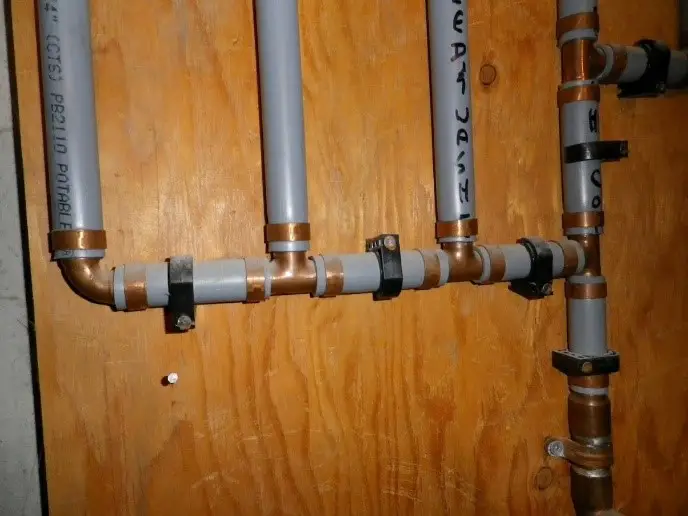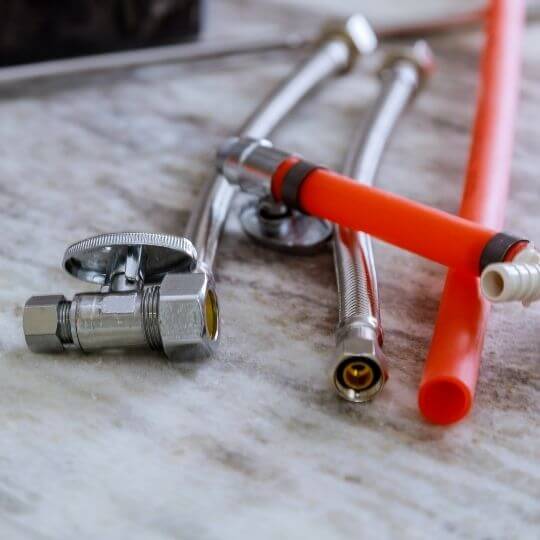Wondering how to identify polybutylene pipes?
Then you are probably living in a house built 30 to 40 years ago or want to buy one.
Polybutylene pipes have a bad reputation and you may have vaguely heard they need to be replaced.
Keep on reading to find out what are polybutylene pipes and what is the problem with them. We will also tell you what to do if you identify them in your home and what to replace them with.
What are polybutylene pipes?

Polybutylene (abbreviated PB) is a plastic resin that has been widely used for water supply pipes between 1978 and 1995. The areas where polybutylene has been used intensively include the ‘Sun Belt’, the Mid Atlantic, and the Northwest Pacific states.
The chemical formula of polybutylene is (C4H8) n. When heated to 190 °C, this type of plastic can easily be compression molded, injection molded, extruded, and welded. It does not crack due to stress and resists impact. [1]
Other uses of PB expect for piping systems are:
- Plastic packaging
- Hot melt adhesives
- In water heaters
- As electrical insulation
- For shoe soles
- To enhance the softness and flexibility of rigid compounds
This type of plastic was mainly developed and produced by the companies Vanguard, Qest, and Shell Oil.
How common are polybutylene pipes?
Experts estimate that 1 in 5 American homes used polybutylene piping in the 80s and early 90s. PB plumbing systems are also found in Europe and Asia, many of them still being in use today.
Polybutylene was very popular and was thought to replace copper successfully while also cutting down on plumbing costs. Enthusiasts used to call it the pipe of the future and praised it for being inexpensive, flexible, and easy to work with. Polybutylene also resisted low temperatures and did not require much expertise to install.
Now that you know the answer to ‘What are polybutylene pipes?’ you are probably wondering what’s the issue with it.
What’s the problem with polybutylene pipes?
Why are polybutylene pipes no longer used?
Their popularity dropped abruptly in 1996. There were multiple reports of polybutylene pipes that were bursting and damaging properties. Polybutylene pipes lawsuits were very common back then and even reached newspaper headlines.
There were two major lawsuits in 1995 regarding damage caused by polybutylene pipes. The $750 million settlement went to families whose homes were damaged by leaking or burst polybutylene pipes. [2]
Studies completed by university experts showed that chemicals found in water react with polybutylene pipes. The main culprit is chlorine, which causes fittings to become brittle.
Eventually, the pipes erode and burst, causing floods and all the associated water damage.
As a result, polybutylene was no longer allowed by building codes. On the other hand, there is no regulation making the replacement of these pipes compulsory.
Some insurance companies, however, ask their clients to replace this type of pipes if they want their homes to be fully insured.
How to identify polybutylene pipes

The first sign of this problem is looking at an older property, one built in the 80s or early 90s. Like many people, you probably love the established neighborhoods of older properties and the complete landscape surrounding them. However, you need to make a careful inspection before closing the deal.
Polybutylene pipes are gray or white with a dull finish. Polybutylene underground water pipes are usually blue but can also be gray or black.
They are 1/2” or 1” in diameter. If you find the code “PB2110”, the pipe you are looking at definitely is polybutylene.
Look for them around the basement wall or floor. They can enter your home near the water heater or can come up through your crawlspace.
You only see copper pipes entering your home?
Don’t hurry to draw conclusions. There have been cases of polyethylene being used inside the home, with copper stub outs. Seeing copper outside does not mean the interior piping is also copper.
Some homeowners mistake PEX for polybutylene, but do not confound them. The former is more flexible and can withstand higher temperatures.
Another thing to look at is water damage. Water stains or leaking on your walls means you should have your pipes checked.
Chances are they are made from polybutylene and will continue to cause damage to your home. Unseen leaks can pool up inside walls and breed toxic mold.
There is some good news, too. This type of pipes was installed in water supply lines only. Do not look for drain, waste, or vent pipes made from PB. Polybutylene piping had a diameter too small to be used for anything else than water supply.
Should I buy a house with polybutylene pipe?
Our recommendation is to not purchase a property with polybutylene pipes.
Buying a house without knowing how to identify polybutylene pipes is not a good idea as the water supply pipes can leak or even burst.
You may save some money in the beginning, but you will spend a lot more in the future on water damage repairs.
There are no regulations that prevent you from buying or selling a property with polybutylene piping.
However, if you want to be sure, hire a home inspector who can identify PB pipes. He or she will be able to determine what material pipes are made of, but will not be able to examine their inside.
What should I do if my home was polybutylene pipes?
Have you discovered polybutylene plumbing in your home?
The best thing to do is to fully replace your water supply system.
Call a licensed plumber to tell you what is involved and how much it will cost you to replace the piping. Costs are higher when piping is located behind finished walls.
If you don’t want to make this investment yet, at least have a licensed plumber to conduct an inspection.
The report will include information on the integrity of polybutylene pipes in your home. You will need to shut off your water and look inside the pipes for flaking and cracking.
Advantages of replacing polybutylene pipes in your home

Replacing the entire water supply system will make a mess in your home and can be quite expensive. On the other hand, making this effort brings you some solid benefits:
- Avoiding future and almost certain water damage and the costly repairs associated with it;
- Increasing your property value;
- Being able to insure your home;
- Selling your property faster and at a better price;
- Achieving peace of mind knowing that your water supply will not burst one day.
What are the alternatives to polybutylene pipes?
Plumbing professionals recommend repiping with PEX. This material is not sensitive to disinfectants and does nor corrode.
PEX is often preferred to copper pipes, which can get pinhole leaks.
Using transition couplings
These couplings are created when you need to make a small repair or transition to new approved piping.
There are two main types of transition couplings:
- Brass Push Fit PB transition coupling
- Crimp type PB transition coupling
Brass Push Fit PB transition coupling seals the outside diameter of the pipe. It can connect PC pipes to copper, PEX, or CPVC. This type of coupling is easy to install and does not require specialized tools.
The Crimp type PB transition coupling is an ASTM-F1807 barbed insert type fitting. It seals on the inside of the pipe by compressing copper crimp rings onto the ends of the PEX pipe. A special crimping tool is required.
How much does it cost to replace polybutylene pipes?
Estimating the costs of polybutylene pipes replacement is very difficult. The final costs depend on:
- The size of the water supply system;
- How much of the piping is located behind finished walls;
- The extent of water damage if there is;
- The type of material you will be using for the new piping system;
- Your location, as plumbing services can be more expensive in some residential areas.
A licensed plumber should be able to provide an estimated cost of this operation.
Read Also: PEX A vs PEX B
Bottomline
Now you know how to identify polybutylene pipes and why they represent a problem.
If your home has a water supply system made with PB, it’s high time to inspect those pipes. The ideal course of action is to replace them.
If you are looking at properties to buy and you find out a house you like has polybutylene piping, give it up! No matter what its advantages are, a property with PB piping is not worth buying. Unless you are considering extensive redecoration work, the mess you will make replacing those pipes will be a huge headache.

Michael Davis is a heating & plumbing expert who currently works as independent contractor in SC. He also writes for Plumbertip.
For almost 10 years he worked on various plumbing tasks across South Carolina.


